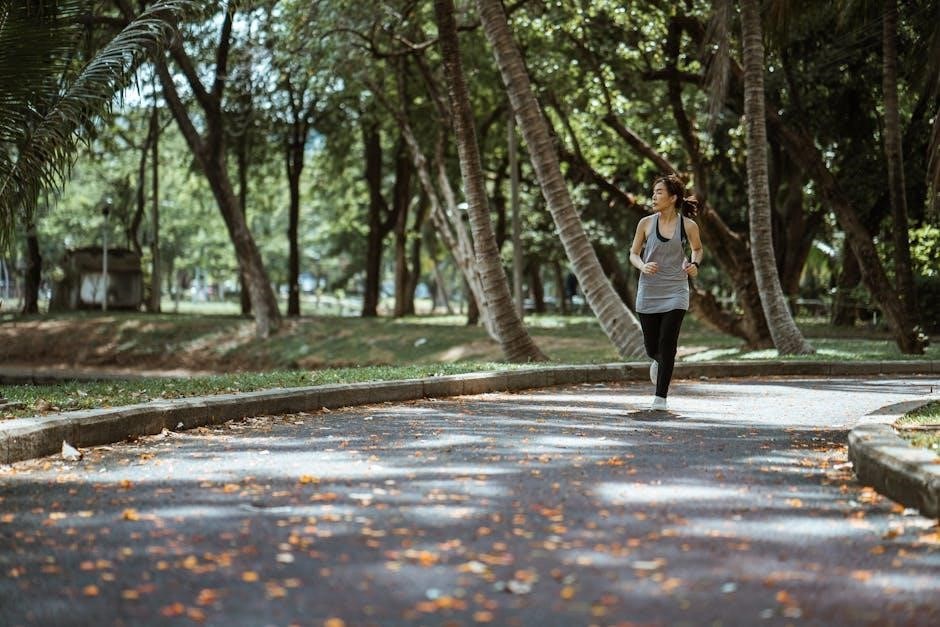
Trail Guide to the Body by Andrew Biel is a hands-on guide for locating muscles, bones, ligaments, and bony landmarks. It offers detailed illustrations and palpation techniques, making it essential for massage, physiotherapy, and healthcare students.
Overview of the Book
Trail Guide to the Body is a comprehensive, hands-on guide designed to help students and practitioners master the musculoskeletal system. With 456 pages and 945 detailed illustrations, it covers 162 muscles, 206 bones, 33 ligaments, and 110 bony landmarks. The book provides a clear, structured approach to learning surface anatomy and palpation techniques, making it an invaluable resource for massage therapy, physiotherapy, and occupational therapy students. Its user-friendly format and rich visual content ensure that complex anatomical information is accessible and easy to understand. The guide also includes pre-learning stories and access to online tools like palpation videos and interactive apps, enhancing the learning experience for both students and professionals.
Author and Edition Details
Trail Guide to the Body is authored by Andrew Biel, a licensed massage practitioner with extensive expertise in anatomy and bodywork. The book is now in its 6th edition, featuring updated full-color illustrations, enhanced graphics, and new chapter content. Biel’s clear, engaging writing style and practical approach have made the guide a favorite among students and professionals. The 6th edition includes pre-learning stories and improved accessibility features, ensuring a seamless learning experience. Published by Books of Discovery, this edition also offers exclusive online resources, such as palpation videos and interactive apps. With its comprehensive updates, the 6th edition solidifies the book’s reputation as a trusted resource for anatomy education. ISBN: 9780991466672.
Target Audience and Purpose
Trail Guide to the Body is designed for students and professionals in massage therapy, physiotherapy, sports therapy, occupational therapy, and other healthcare fields. Its primary purpose is to provide a clear, hands-on approach to learning human anatomy, focusing on palpation techniques and surface anatomy. The book is particularly useful for those needing to locate muscles, bones, ligaments, and bony landmarks with precision. It serves as both a classroom textbook and a practical reference for clinicians, offering a user-friendly guide to mastering manual therapy skills. By combining detailed illustrations with step-by-step instructions, the guide empowers learners to confidently navigate the musculoskeletal system, making it an indispensable tool for both education and professional practice.
Key Features of the Trail Guide to the Body
Trail Guide to the Body features detailed illustrations, comprehensive coverage of muscles, bones, ligaments, and bony landmarks, and practical palpation techniques. It includes interactive study tools like flashcards and apps to enhance learning and retention, making it a versatile resource for anatomy education.
Detailed Illustrations and Content
Trail Guide to the Body is renowned for its detailed illustrations, with over 945 visuals covering 162 muscles, 206 bones, 33 ligaments, and 110 bony landmarks. These visuals are meticulously crafted to provide a clear and accurate representation of the human musculoskeletal system, aiding learners in understanding complex anatomical structures. The content is organized to facilitate a deep understanding of surface anatomy, making it easier for students to grasp the spatial relationships between different body parts. The illustrations are complemented by concise descriptions, ensuring that learners can identify and locate anatomical features with precision and confidence. This visual and textual combination makes the book an indispensable tool for anatomy education;
Coverage of Muscles, Bones, Ligaments, and Bony Landmarks
Trail Guide to the Body provides comprehensive coverage of the musculoskeletal system, detailing 162 muscles, 206 bones, 33 ligaments, and 110 bony landmarks. Each anatomical structure is meticulously described, offering learners a thorough understanding of their location, function, and relationships. The book’s detailed approach ensures that students can identify and palpate structures with accuracy. This extensive coverage makes it an essential resource for mastering manual therapy skills. The inclusion of both superficial and deep structures allows learners to build a layered understanding of anatomy, enhancing their ability to assess and treat effectively. This systematic breakdown of the body’s musculoskeletal components is a cornerstone of the book’s educational value.
Surface Anatomy and Palpation Techniques
Trail Guide to the Body excels in teaching surface anatomy and palpation techniques, enabling learners to locate anatomical structures with ease and precision. The guide uses detailed illustrations and clear instructions to help students master manual therapy skills. By emphasizing palpation, it empowers professionals to confidently assess and treat the body. The book’s step-by-step approach ensures that learners can identify muscles, bones, and ligaments through touch, enhancing their clinical expertise. The integration of visual and tactile learning aids makes the process intuitive and effective. This focus on practical application sets it apart as an indispensable tool for both students and practitioners in bodywork and healthcare fields.
Learning Aids and Study Tools
The book offers pre-learning stories, audio guides, and interactive apps to enhance learning. It also provides online resources, including palpation videos and overlay images, for comprehensive study.
Pre-Learning Content and Stories
Trail Guide to the Body includes pre-learning stories that engage students with real-life scenarios, making complex anatomy concepts relatable. These narratives help learners connect theoretical knowledge with practical applications, enhancing retention and understanding. By presenting information in a contextual manner, the book simplifies the learning process, ensuring students grasp essential muscle, bone, and ligament details effectively. This approach fosters a deeper connection between the material and the learner, making anatomy more accessible and memorable. The stories also serve as a foundation for the detailed illustrations and palpation techniques covered later in the guide.
Audio Guides and Terminology Clips
Trail Guide to the Body is complemented by audio guides and terminology clips, offering students an interactive way to learn anatomical terms and concepts. These resources provide clear pronunciations, definitions, and explanations, helping learners master the language of anatomy. The audio guides enhance understanding by pairing visual content with auditory learning, making complex terms easier to grasp. Additionally, the terminology clips offer bite-sized lessons, perfect for quick reviews and study sessions. These tools are designed to work seamlessly with the book, ensuring a comprehensive and engaging learning experience. They are accessible online, allowing students to study anytime and anywhere, further enriching their journey through the musculoskeletal system.
Interactive Mobile Apps and Online Resources
Trail Guide to the Body offers interactive mobile apps and online resources to enhance learning. These tools include palpation videos, overlay images, and interactive quizzes. The apps allow students to explore the musculoskeletal system in depth, with 3D models and guided lessons. Online resources provide anytime access, making it ideal for self-paced study. The interactive features help reinforce concepts from the book, ensuring a dynamic and engaging experience. These digital tools are designed to support both visual and kinesthetic learners, making anatomy education accessible and effective for a wide range of students and professionals in massage therapy, physiotherapy, and healthcare fields.

Structure and Organization of the Book
Trail Guide to the Body is organized as a step-by-step learning journey, covering muscles, bones, and ligaments with detailed illustrations and clear instructions for easy comprehension.
Step-by-Step Learning Journey
The book is designed as a step-by-step learning journey, guiding students through the musculoskeletal system with clear, logical progression. Each section builds on the previous one, starting from surface anatomy and progressing to deeper structures. This approach ensures that learners can systematically develop their knowledge and palpation skills. The structured format helps students master complex anatomy by breaking it down into manageable parts, making the learning process engaging and effective. This methodical journey from superficial to deep tissues aligns with how professionals assess and treat the body, enhancing both theoretical understanding and practical application.
Chapters and Sections Breakdown
Trail Guide to the Body is organized into comprehensive chapters and sections, each focusing on specific anatomical regions. The book is divided into logical sections, starting with surface anatomy and progressing to deeper structures. Each chapter provides detailed information on muscles, bones, ligaments, and bony landmarks, making it easy for learners to navigate. The breakdown ensures that students can focus on one area at a time, enhancing retention and understanding. With clear headings and subdivisions, the book offers a structured approach to learning anatomy, allowing users to quickly locate and study specific body regions. This systematic organization makes it an invaluable resource for both students and professionals.
Visual and Textual Learning Aids
Trail Guide to the Body combines stunning visuals with clear, concise text to enhance learning. The book features over 1,400 detailed illustrations, including full-color graphics in the 6th edition, which provide a clear map of the body’s structures. Accompanying these visuals are pre-learning stories and audio guides that simplify complex anatomical concepts. These aids make it easier for students to grasp and remember key information. The integration of visual and textual elements ensures a comprehensive understanding of musculoskeletal anatomy, while the audio guides and terminology clips offer additional support for different learning styles. This multi-faceted approach creates a dynamic and engaging learning experience, making the book a valuable tool for anatomy education.

Benefits for Students and Professionals
Trail Guide to the Body aids students and professionals in mastering palpation and surface anatomy, enhancing their manual therapy skills and clinical practice effectiveness.
For Massage Therapy Students
Trail Guide to the Body is an indispensable resource for massage therapy students, offering detailed illustrations and palpation techniques to master the musculoskeletal system. It covers 162 muscles, 206 bones, and 33 ligaments, providing a clear map of the body. The book’s user-friendly design and step-by-step guidance make complex anatomy accessible, enabling students to locate structures with precision. Its focus on surface anatomy and hands-on learning aids in developing practical skills for assessments and treatments. By enhancing palpation mastery, the guide empowers students to confidently apply their knowledge in clinical settings, making it an essential tool for aspiring massage therapists.
For Physiotherapy and Sports Therapy Practitioners
Trail Guide to the Body is a valuable resource for physiotherapy and sports therapy practitioners, offering detailed insights into the musculoskeletal system. It provides comprehensive coverage of 162 muscles, 206 bones, and 33 ligaments, along with 110 bony landmarks, aiding in precise palpation and assessment. The book’s clear illustrations and step-by-step guidance enhance understanding of surface anatomy, making it easier to locate and treat structures effectively. Its focus on hands-on learning supports clinical practice, particularly in rehabilitation and injury management. Additional resources like palpation videos and interactive tools further enrich the learning experience, ensuring practitioners can confidently apply their knowledge in diverse therapeutic settings.
For Occupational Therapy and Healthcare Professionals
Trail Guide to the Body is an indispensable tool for occupational therapy and healthcare professionals, providing a detailed map of the musculoskeletal system. It covers 162 muscles, 206 bones, 33 ligaments, and 110 bony landmarks, enabling precise palpation and anatomical understanding. The book’s clear illustrations and step-by-step guidance support clinical reasoning and practical application, particularly in rehabilitation and patient care. Its focus on surface anatomy and hands-on techniques aids in assessing and addressing patient needs effectively. Additionally, the accompanying online resources, such as palpation videos and interactive tools, offer ongoing education and professional development, making it a comprehensive resource for enhancing therapeutic interventions and improving patient outcomes.

Updates in the 6th Edition
The 6th edition features full-color illustrations, enhanced graphics, and new chapter content. It includes pre-learning stories, improved accessibility, and expanded online resources like palpation videos and mobile apps.
Full-Color Illustrations and Enhanced Graphics
The 6th edition of Trail Guide to the Body features stunning full-color illustrations, replacing the previous monochrome images. These vibrant visuals provide exceptional clarity, making it easier for students to identify anatomical structures. Enhanced graphics include detailed depictions of muscles, bones, ligaments, and bony landmarks, offering a 3D-like depth that aids in understanding complex anatomy. The updated artwork ensures consistency across all chapters, while the use of color coding highlights specific structures, improving learning retention. These visual improvements make the musculoskeletal system more accessible and engaging, especially for hands-on learners. The enhanced graphics also complement the book’s palpation techniques, creating a seamless bridge between visual learning and practical application.
New Chapter Features and Additional Content
The 6th edition introduces exciting new chapter features and expanded content, enhancing the learning experience. Pre-learning stories now precede each section, providing context and engaging students with real-world scenarios. New chapters incorporate updated information on muscles, bones, and ligaments, ensuring comprehensive coverage. Additional content includes enhanced palpation techniques and expanded surface anatomy details, offering deeper insights into practical applications. These improvements make the guide more accessible and engaging, catering to diverse learning styles. The new features seamlessly integrate with existing material, creating a cohesive and enriched educational resource for anatomy students and professionals alike. This edition solidifies the book’s reputation as a leader in anatomy education.
Improved Accessibility and Study Tools
The 6th edition of Trail Guide to the Body offers enhanced accessibility and study tools, empowering learners with versatile resources. Students gain exclusive access to a wealth of free study aids, including palpation videos, overlay images, and interactive mobile apps. These tools are available online, allowing anytime, anywhere access to support learning. Pre-learning stories and audio guides with terminology clips enrich the educational experience, catering to diverse learning styles. The improved digital platform ensures seamless navigation and engagement, while the addition of new chapter features and content further enhances the book’s utility. These updates make the guide more accessible and user-friendly, providing students with a comprehensive and flexible learning experience tailored to their needs. The integration of technology and traditional learning methods creates a dynamic and effective study environment.
Complementary Materials and Resources
- Trail Guide to the Body Flashcards provide visual and tactile learning aids for memorizing muscles, bones, and ligaments.
- A Workbook and Laboratory Manual offers practical exercises and activities to reinforce anatomical knowledge.
- An Online Community and Support connects learners, offering forums, updates, and additional study resources.
Trail Guide to the Body Flashcards
The flashcards are a valuable companion to the main textbook, offering portable and interactive learning tools. They cover 162 muscles, 206 bones, and 33 ligaments, aiding in memorization and quick reference. Each card features detailed illustrations and key information, making them ideal for on-the-go study. Students can use them to test their knowledge and reinforce concepts learned from the book. The flashcards are particularly useful for visual learners, providing a hands-on way to master complex anatomical details. They are widely praised for their clarity and effectiveness in preparing for exams and practical assessments in massage, physiotherapy, and related fields.
Workbook and Laboratory Manual
The Workbook and Laboratory Manual complements the Trail Guide to the Body, offering practical exercises and activities to deepen anatomical understanding. It features step-by-step palpation exercises, review questions, and labeling activities to reinforce learning. Designed for hands-on practice, the manual helps students apply theoretical knowledge in real-world scenarios. It is particularly useful for massage therapy, physiotherapy, and occupational therapy students, providing a structured approach to mastering surface anatomy and manual techniques. The workbook includes detailed instructions, visual aids, and self-assessment tools, making it an indispensable resource for both classroom and individual study. It bridges the gap between textbook learning and clinical practice, ensuring students are well-prepared for professional environments.
Online Community and Support
The Trail Guide to the Body is supported by an extensive online community and resources, enhancing the learning experience. Students and professionals gain access to interactive tools, palpation videos, and pre-learning content. The online platform offers overlay images, audio guides, and terminology clips to aid comprehension. Additionally, the companion mobile app provides on-the-go access to study materials, making it easier to review anatomical structures anywhere. The online community fosters collaboration, allowing users to share insights and ask questions. These resources create a dynamic and engaging environment, ensuring learners stay connected and supported throughout their anatomical education journey. This comprehensive support system underscores the book’s commitment to fostering mastery of the musculoskeletal system.

Impact and Reception in the Educational Community
Trail Guide to the Body is acclaimed as a gold-standard textbook, widely used in educational institutions. Its popularity stems from its clear, engaging approach to anatomy education, supported by testimonials from students and instructors worldwide, making it a cornerstone in massage, physiotherapy, and healthcare training programs.
Acclaimed as a Gold-Standard Textbook
Trail Guide to the Body is widely recognized as a gold-standard textbook in anatomy education. Its popularity and acclaim stem from its detailed, lifelike illustrations and user-friendly approach to learning palpation and musculoskeletal anatomy. With 504 pages and 1,400 illustrations covering 162 muscles, 206 bones, 33 ligaments, and 110 bony landmarks, it provides a comprehensive map of the body. The book’s engaging content, including pre-learning stories and audio guides, has made it a favorite among students and instructors. Its interactive tools and accessibility features further enhance its reputation as an essential resource for massage therapy, physiotherapy, and healthcare professionals, solidifying its place as a cornerstone in anatomy education.
Testimonials from Students and Instructors
Students and instructors alike praise Trail Guide to the Body for its clarity and effectiveness. Many describe it as indispensable for mastering musculoskeletal anatomy and palpation techniques. Massage therapy students highlight its practicality, while physiotherapy instructors commend its ability to make complex concepts engaging. The book’s detailed illustrations and step-by-step guidance are frequently praised for aiding in both classroom and clinical settings. Testimonials often emphasize how the guide transforms anatomy learning into an interactive and memorable experience, making it a favorite among healthcare professionals and students alike. Its reputation as a gold-standard textbook is further reinforced by its widespread adoption in educational institutions worldwide.
Popularity and Usage in Educational Institutions
Trail Guide to the Body is widely adopted in educational institutions worldwide, serving as a primary textbook for massage therapy, physiotherapy, and occupational therapy programs. Its detailed illustrations and structured approach make it a favorite among students and instructors. The book’s popularity stems from its ability to simplify complex anatomical concepts, making it accessible for learners at all levels. Many schools integrate it into their curricula due to its comprehensive coverage of muscles, bones, and ligaments. With over 945 illustrations, it provides a visual learning experience that enhances retention. Its availability in spiral-bound and digital formats further increases its accessibility, solidifying its place as a go-to resource in anatomy education.
Trail Guide to the Body stands as a gold-standard resource for anatomy education, offering unmatched clarity and depth. Its detailed illustrations and practical approach make it indispensable for students and professionals alike, ensuring its continued relevance in the field of manual therapy and beyond.
Importance of the Trail Guide to the Body in Anatomy Education
Trail Guide to the Body is a cornerstone in anatomy education, providing a comprehensive and accessible guide to the musculoskeletal system. Its detailed illustrations, palpation techniques, and step-by-step approach make it an invaluable tool for students and professionals. By bridging the gap between theoretical knowledge and practical application, it empowers learners to master essential manual therapy skills. The book’s focus on surface anatomy and hands-on learning enhances understanding and retention, solidifying its role as a gold-standard textbook in the field. Its widespread adoption across various therapies underscores its importance in modern anatomy education.
Future of Anatomy Learning with Trail Guide to the Body
The future of anatomy learning is poised to evolve significantly with the Trail Guide to the Body. As digital tools and interactive resources become more prevalent, the guide may expand its offerings with 3D models, virtual palpation simulations, and personalized learning paths. Enhanced online resources, such as AI-driven study aids and real-time feedback systems, could further enrich the learning experience. The integration of augmented reality (AR) and virtual reality (VR) technologies might allow students to explore anatomy in immersive, interactive environments. By continuously adapting to technological advancements, the Trail Guide to the Body will remain a pivotal resource, shaping the future of anatomy education with innovative and engaging tools for learners worldwide.